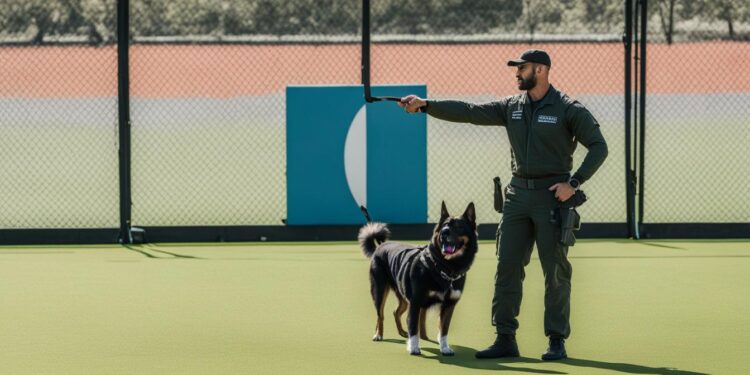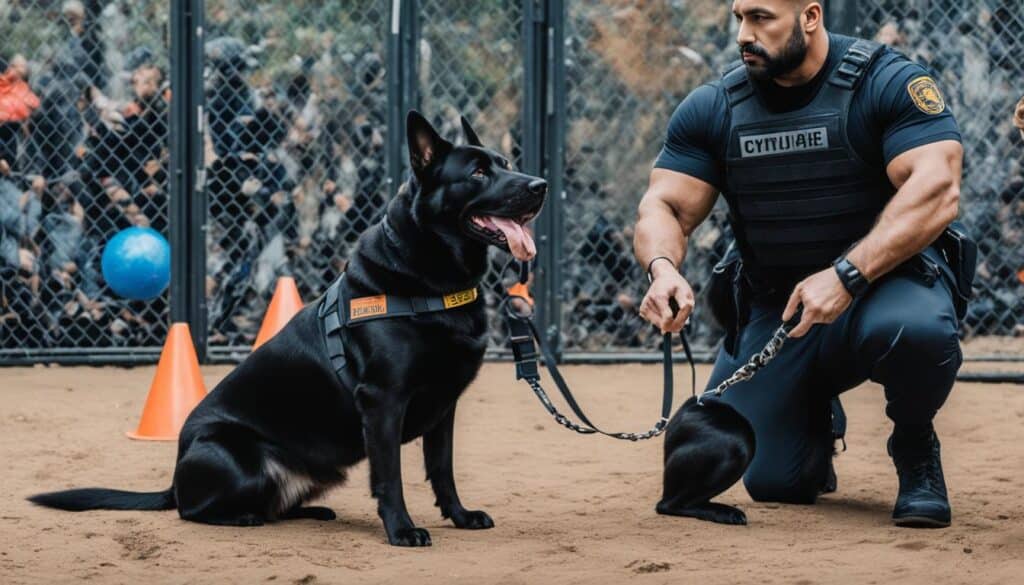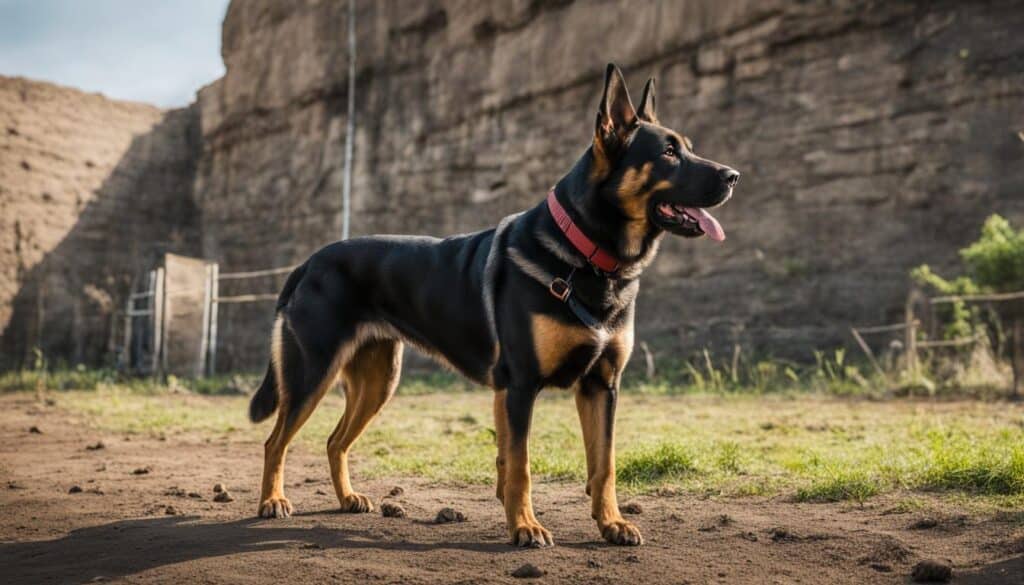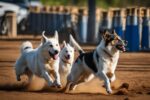Essentials of Training a Guard Dog: Safety and Control

When it comes to guard dog training, safety and control are of utmost importance. Training a guard dog involves more than just protection; it also focuses on behavior and obedience. Understanding the difference between a guard dog and an attack dog is crucial.
Before delving into guard dog training, it’s essential to determine if your dog’s breed is suitable for this role. Certain breeds, like German Shepherds, Rottweilers, Doberman Pinschers, and Belgian Malinois, are known for their intelligence, loyalty, and protective instincts, making them ideal candidates for guard dog training.
Socialization plays a vital role in the development of a well-rounded guard dog. Introduce your dog to various environments, people, and animals from a young age. This exposure helps reduce aggression towards strangers and improves their responsiveness to commands.
Basic obedience training lays the foundation for control and effective communication between you and your dog. Teach your dog essential commands like sit, stay, come, and heel using positive reinforcement techniques like treats and praise.
Lastly, developing specific guard dog skills like barking on command, stopping barking, and following a guard command enhances their ability to protect and respond to potential threats. Professional protection training can also be considered for advanced skills.
Remember, training a guard dog requires dedication, consistency, and a strong bond between you and your furry companion. By following these essential steps and committing to responsible ownership, you can have a well-trained guard dog that offers both protection and companionship.
Choosing the Right Breed for Guard Dog Training
When it comes to guard dog training, selecting the right breed is crucial. Certain breeds possess natural instincts and characteristics that make them ideal for this role. German Shepherds, Rottweilers, Doberman Pinschers, and Belgian Malinois are among the most popular choices for guard dog training.
German Shepherds are known for their intelligence, loyalty, and versatility. They are highly trainable and excel in various tasks, including guarding homes and businesses. Rottweilers, with their strong protective instincts and imposing presence, are also commonly used as guard dogs.
Doberman Pinschers are renowned for their fearlessness, loyalty, and agility. Their natural guarding instincts make them exceptional candidates for guard dog training. Belgian Malinois, similar to German Shepherds, are intelligent, hardworking, and obedient. They possess a strong work ethic and are often employed in law enforcement and military roles.
While these breeds are well-suited for guard dog training, it’s important to note that smaller dog breeds may not possess the physical size and strength needed for effective protection. However, some small breeds can still be trained for personal protection.
Remember, choosing the right breed is just the first step. Proper training and socialization are key factors in developing a well-rounded and reliable guard dog.
“The loyalty, intelligence, and protective instincts of breeds like German Shepherds, Rottweilers, Doberman Pinschers, and Belgian Malinois make them excellent options for guard dog training.” – Professional Dog Trainer
Socializing Your Guard Dog
Socializing your guard dog is an essential aspect of their training. By exposing them to various environments, people, and animals from a young age, you can help them develop proper behavior and reduce aggression towards strangers. Socialization also makes them more responsive to commands, ensuring effective control in different situations.
Proper socialization helps guard dogs become well-rounded and confident individuals. It allows them to adapt to new environments and maintain composure even in unfamiliar surroundings.
To socialize your guard dog effectively, incorporate the following practices into their training routine:
- Expose them to different environments: Take your dog on regular walks in various locations to expose them to different sights, sounds, and smells. This exposure helps them become more comfortable and confident in new environments.
- Introduce them to people: Invite friends, family, and acquaintances to interact with your dog in a controlled environment. Gradually expose them to different types of people, including adults, children, and individuals wearing different attire.
- Provide positive interactions with animals: Arrange playdates with friendly, well-behaved dogs to promote positive socialization. This interaction helps them understand appropriate behavior around other animals and prevents aggressive tendencies.
Benefits of Socialization
Socializing your guard dog offers a range of benefits:
| Benefits of Socialization | |
|---|---|
| Reduced aggression | Socializing your dog helps reduce aggression towards strangers and other animals, making them easier to control in various situations. |
| Improved obedience | Well-socialized dogs are more attentive and responsive to commands, enhancing their overall obedience. |
| Confidence and adaptability | Socialized dogs are confident and adaptable, allowing them to adapt to new environments and handle unpredictable situations without fear or anxiety. |
| Reduced stress | Exposing your dog to different environments and social interactions helps reduce stress and anxiety in unfamiliar situations. |
Incorporating socialization into your guard dog’s training program is crucial for their overall development and effectiveness in their role. Take the time to ensure they are exposed to different environments, people, and animals in a controlled and positive manner.
Basic Obedience Training for Guard Dogs
Teaching your guard dog basic obedience commands is crucial for control and building a strong bond. By establishing a solid foundation of obedience, you can ensure that your guard dog will listen and respond effectively in various situations.
Start with the sit command, which is one of the fundamental obedience commands. It teaches your dog to immediately sit down on command, providing a sense of discipline and control.
To train your dog to sit, follow these steps:
- Hold a treat close to your dog’s nose, allowing them to sniff it.
- Slowly move the treat upwards, towards the top of your dog’s head. As their nose follows the treat, their bottom should naturally lower into a sitting position.
- Once your dog is sitting, say the command “sit” and immediately reward them with the treat and praise.
- Repeat this process multiple times, gradually reducing the need for the treat as your dog becomes more familiar with the command.
Remember to always use positive reinforcement, such as treats and praise, to reward good behavior. Consistency is essential during obedience training to ensure that your dog understands and consistently follows the commands.
Once your dog masters the sit command, you can proceed to other basic commands like stay, come, and heel. These commands provide further control over your guard dog’s behavior and movements.
Here is a quick overview of these commands:
- Stay: Teach your dog to remain in a stationary position until you give them a release command. This command is useful for situations where you want your dog to stay put, ensuring their safety and preventing them from wandering off.
- Come: Train your dog to come to you when called. This command is crucial for recall and ensuring that your dog returns to you instantly, especially in potential danger.
- Heel: Teach your dog to walk alongside you without pulling on the leash. This command promotes proper leash manners and allows you to maintain control and focus during walks or in public spaces.
| Basic Obedience Commands | Description |
|---|---|
| Sit | Teaches your dog to sit down on command, promoting discipline and control. |
| Stay | Requires your dog to maintain a stationary position until given a release command, ensuring their safety and preventing wandering. |
| Come | Trains your dog to come to you when called, promoting recall and immediate response, especially in potential danger. |
| Heel | Teaches your dog to walk alongside you without pulling on the leash, promoting leash manners and control during walks. |
Incorporating these basic obedience commands into your guard dog’s training routine is essential for their development and overall effectiveness as a protector. Regular practice, patience, and positive reinforcement will ensure that your dog becomes obedient, responsive, and trustworthy in any situation.

Developing Guard Dog Skills
Developing specific guard dog skills is essential in guard dog training. These skills help your dog become an effective protector and enhance their ability to respond to potential threats. Here are key skills to focus on:
Bark on Command
Training your guard dog to bark on command is a crucial skill for alerting you to potential dangers. Use a trigger word or phrase to prompt your dog to bark, and reward them when they obey. Consistency and positive reinforcement are key to reinforcing this behavior.
Stop Barking on Command
Equally important is teaching your guard dog to stop barking on command. Excessive barking can be disruptive and draw unnecessary attention. Use a consistent command, such as “quiet” or “enough,” and reward your dog when they cease barking. With practice, your dog will learn to stop barking on command, maintaining peace and quiet when needed.
Introduce a Guard Command
Incorporate a specific command that instructs your guard dog to guard a particular area or person. This command signals to your dog that they should stay vigilant and protect the designated target. Consistent training and positive reinforcement will reinforce this behavior, ensuring your dog understands their role as a guardian.
Consider Professional Protection Training
For advanced guard dog skills, such as recognizing threats and responding appropriately, consider enrolling your dog in professional protection training. These programs are designed to enhance your dog’s abilities and provide specialized training in various protective tasks. Working with experienced trainers can help take your guard dog training to the next level.

Remember, developing guard dog skills requires patience, consistency, and proper training techniques. Regular practice sessions and ongoing reinforcement will ensure that your dog becomes proficient in these essential skills.
Conclusion
Training a guard dog is a commitment that requires patience, consistency, and a deep understanding of canine behavior. It involves a series of crucial steps, including choosing the right breed, socializing your dog, teaching basic obedience, and developing specific guard dog skills. By following these steps, you can ensure that your guard dog is well-prepared to provide added safety and security for your home or business.
Responsible ownership is key in guard dog training. It entails regular practice, maintaining a strong bond with your dog, and being attentive to their needs. Building a strong bond is essential for effective training and creating a mutual trust between you and your guard dog. This bond forms the foundation for a harmonious and successful partnership.
A well-trained guard dog not only offers protection but also becomes a loyal companion. They can provide you with peace of mind, knowing that you have a vigilant and obedient companion by your side. Remember that training is an ongoing process that requires dedication and commitment. With the proper training and care, your guard dog can truly fulfill their role while being a beloved member of the family.
FAQ
What is the difference between a guard dog and an attack dog?
A guard dog is trained to protect property and people by being alert and intimidating, while an attack dog is trained to engage in physical confrontation and aggressive behavior.
What are some typical guard dog breeds?
German Shepherds, Rottweilers, Doberman Pinschers, and Belgian Malinois are known for their intelligence, loyalty, and protective instincts, making them ideal for guard dog training.
Can small dog breeds be trained as guard dogs?
While small dog breeds may not have the physical size and strength of larger breeds, some small breeds can still be trained for personal protection with the right training and guidance.
Why is socializing a guard dog important?
Socializing a guard dog from a young age helps reduce aggression towards strangers and makes them more responsive to commands. It also helps them feel comfortable in different environments.
What are some basic obedience commands for guard dogs?
Teaching guard dogs basic obedience commands such as sit, stay, come, and heel is crucial for control and building a strong bond with your dog.
How can I teach my guard dog to bark on command?
You can train your guard dog to bark on command by using a trigger word and rewarding them when they bark. Consistent practice and positive reinforcement are key.
What should I do to develop specific guard dog skills?
To develop specific guard dog skills, you can introduce a guard command to instruct your dog to guard a specific area or person. Consider professional protection training for advanced skills such as recognizing threats and responding accordingly.
What is important to remember about guard dog training?
Guard dog training requires patience, consistency, and a deep understanding of canine behavior. It is important to choose the right breed, socialize your dog, teach basic obedience, and continuously practice and maintain a strong bond. Being a responsible owner is crucial for successful guard dog training.





